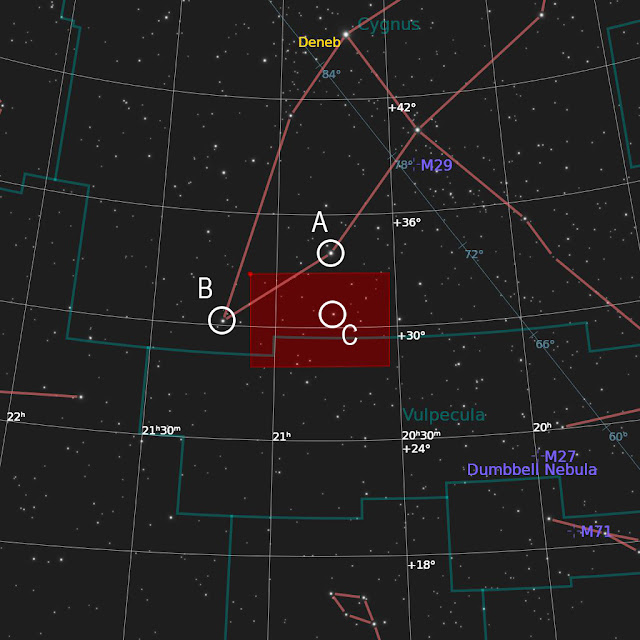California dreaming on a beautiful Autumn Night ...
 |
| NGC 1499, The California Nebula captured from my backyard on 10/3/2025 |
What is it? (Written with AI assistance)
 |
| An annotated version of the image of NGC 1499 |
When you first look at the California Nebula (NGC 1499),
it’s easy to see why it earned its name. Stretching across the constellation
Perseus, its glowing hydrogen clouds trace an outline reminiscent of the U.S.
state of California. But beyond its striking resemblance, this nebula tells a
much deeper story—one that spans the entire cycle of stars and reaches far
beyond our galaxy.
A Star Ignites a Nebula
At the heart of this glowing cloud lies Xi Persei
(Menkib), a massive O-type star. Its fierce ultraviolet radiation ionizes
the surrounding hydrogen gas, causing the nebula to shine in vivid reds and
pinks. In my HOO color mapping, hydrogen dominates in red, while faint traces
of oxygen shimmer in blue (maybe a hint of teal). This interplay of light
reveals the raw energy of a star powerful enough to sculpt an entire nebula.
A Catalog of Cosmic Neighbors
The California Nebula is also known as Sharpless 2-220,
part of a catalog dedicated to hydrogen-rich regions. But what makes this field
truly fascinating is the company it keeps. Scattered across the same frame are
dozens of faint galaxies, each labeled with IC (Index Catalogue)
designations. Unfortunately, most aren't visible in the wide-field image captured with a dual-narrowband filter. These galaxies, such as IC 2000–2007, IC 2027 and IC 1994–1999,
are not part of the nebula at all—they lie far beyond, their light traveling
hundreds of millions of years to reach us. in my image, IC 2005 is actually behind the nebula and IC 2027 appears as a tiny star like point.
And then there’s a surprise: IC 2003, a planetary
nebula. Unlike the sprawling California Nebula, this is the remnant of a dying
star, a shell of gas cast off as the star’s core contracts. To capture both a
stellar nursery and a stellar grave in the same field is a rare and poetic
juxtaposition.
A Cosmic Juxtaposition
This single image contains three layers of the universe’s
story:
- Stellar
Birth: The California Nebula, where new stars are forming.
- Stellar
Death: IC 2003, a planetary nebula marking the end of a star’s life.
- Galactic
Distance: The faint IC galaxies, silent witnesses from far beyond the
Milky Way.
Together, they remind us that the night sky is not a flat
canvas but a vast, three-dimensional tapestry. What looks like a single scene
is actually a layered story of creation, transformation, and unimaginable
distance.
Why It Matters
For me, this is what astrophotography is all about—not just
capturing light, but capturing meaning. A single frame can hold the birth of
stars, the death of stars, and the light of galaxies so distant they make our
own Milky Way feel small. The California Nebula is more than a pretty
picture—it’s a reminder that the universe is always telling stories, if we take
the time to listen.
How big is it?
NGC 1499 has an angular distance of 145.0 x 45.0 arcminutes (1 degree is 60 arcminutes) on the night sky. For reference, the Sun and the Moon have an angular distance of 31 arcminutes on the sky. It is about 74.3 light-years (ly) long.
How far is it?
NGC 1499 is located about 1,800 light-years (ly) from Earth in the Constellation Perseus.
How to find it?
NGC is faint but can be observed visually. due to it's large size, an instrument with a wide field of view is best. Dark skies and an Nebula filter (especially H-Beta) are very helpful. Refer to the finder chart below. The Red Rectangle indicates the field of view for the image.
 |
| Finder Chart for NGC 1499 |
Imaging Notes:
Friday October 3rd was forecast to be clear all night. After getting home from work, I set up my wide-field imaging rig. Since the Moon was nearly full (full Moon was on 10/6), an emission nebula (NGC 1499) was selected as the target and a dual-narrowband filter was used to fight against the light from the Moon.
Since NGC 1499 didn't clear the trees until after 12:30 AM, I collected some narrowband data on M31 with the hopes being able to get Ha to add to my M31 image. The first sub rolled in at 12:45 AM. The skies were pretty good. Transparency and seeing were above average. I went to sleep around 1:30 AM. The rig kept collecting subs until 6:07 AM. A total of 92 good sub exposures were collected.
Processing:
All pre and post processing was performed in PixInsight. Pre-Processing: All subs were visually inspected with Blink and subs with issues were removed. All light Frames, Flats, Darks and Dark flats were loaded into WBPP. Linear Post Processing: Background extraction was performed with DBE followed by BXT (correct only). SPCC was used for Color Calibration followed by a full application of BXT. The Stars were removed using StarXT. Starless Linear: Noise was reduced with NXT. The image was made non-linear with HT. Linear Stars: The stars were made non-linear with Seti Astro's Star Stretch Script.
Non-linear Post Processing: Starless: The Narrowband Normalization process was used in in mode 2 to get the "HOO look". Color, intensity, and contrast were adjusted with various applications of CT. Saturation was increased with CT. The Image blend Script was used to sharpen the image with a High Pass Filter. LHE was applied at 2 Kernel sizes and Unsharp mask was applied. CT was used to increase contrast. Stars: Saturation was increased with CT. SCNR was applied and the Correct Magenta Stars Script was used to help with stars captured with a dual narrowband filter. CT was used to adjust contrast one last time. Final: The Stars and Starless images were combined with Pixel Math to produce the final image.























